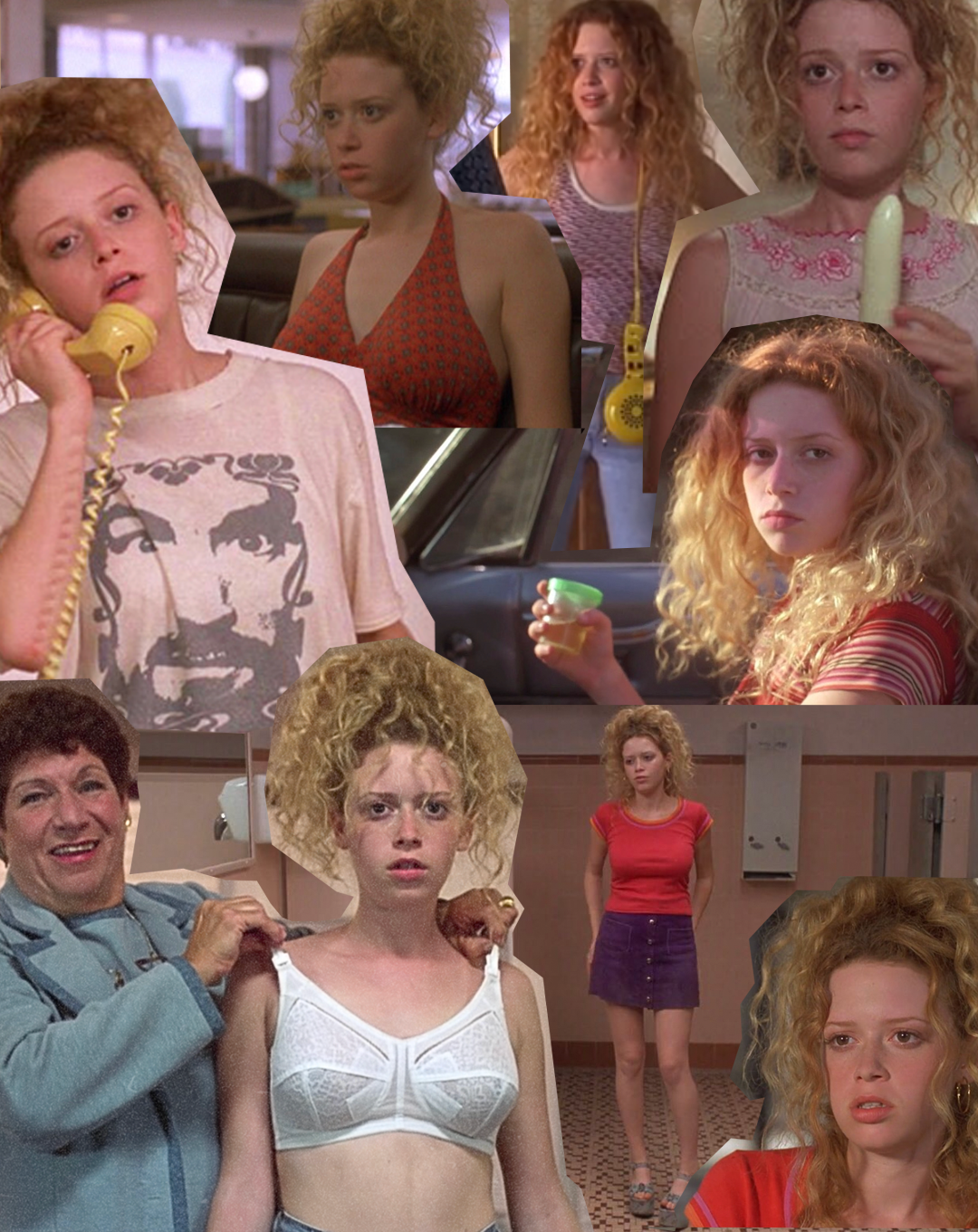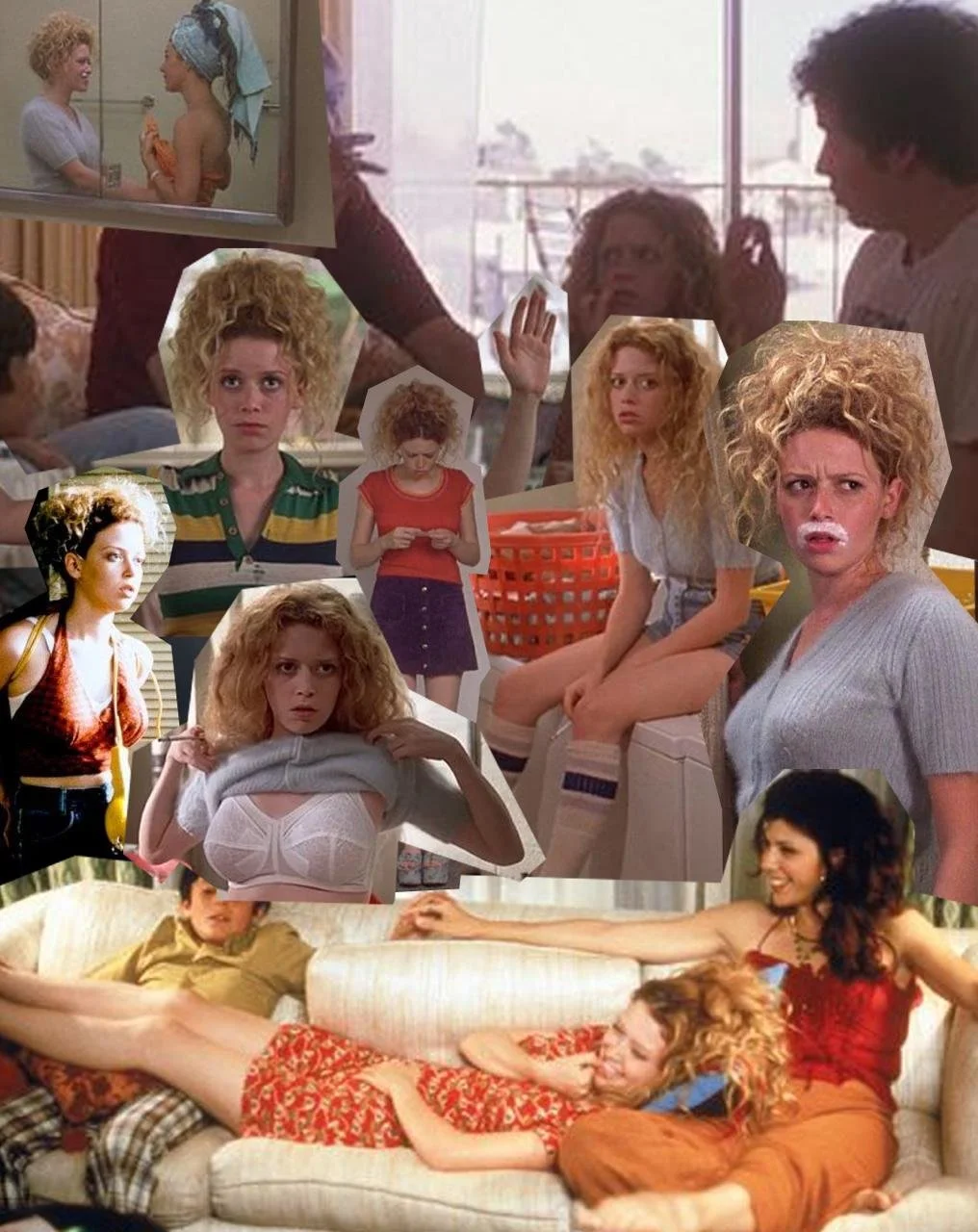Film Fatale: Slums of Beverly Hills and a Different Type of Girlhood
Words: Charlotte Amy Landrum
Make it stand out
When I saw this screenshot of Natasha Lyonne in a raggedy Charles Manson t-shirt, a yellow telephone in hand, and her gorgeous mane of strawberry blonde hair tied up into a ponytail, I knew I was in for a winner. I came across the image around the age of 15, on Tumblr of course. In order to make this image my pfp with sound mind - and to see just what Lyonne was doing in that Manson shirt - I had to watch the film it came from: Slums of Beverly Hills directed by Tamara Jenkins in 1998.
In this raunchy coming of age film, we follow an 18 year old Lyonne playing 14 year old Vivian Abromowitz, a character that has the signature boyish charm Lyonne gives us in many of her roles, predicating Nadia Vulvokov, a chainsmoking computer coder, from the Netflix series Russian Doll and But I’m a Cheerleader (1999) where Lyonne plays a lesbian going through conversion therapy led by RuPaul. She is raspy voiced and pissed off at any obtuse gender stereotypes that are imposed or expected of her. The characters Lyonne typically plays always wanting to do their own thing but are faced with frustratingly unique obstacles, yet in the case of Slums of Beverly Hills, the trope gets uncomfortably relatable when puberty gets in the way.
Protagonist Vivian is in teenage girl purgatory. Her father is bad with money and is constantly moving her and her two brothers from sleazy rental to sleazy rental - apartments known as ‘dingbats’ - until they decide the next stop is in Beverly Hills, for the “good schools”. The family now live in extremely close proximity to the celebrity elites, but only because the four of them are living in a one bed apartment that has a dead cat in the oven on move-in day.
What all of the Abromowitz’s have in common, at the very least, is the overwhelming desire to appear normal and upper middle class. Yet they all struggle to convey regularity due to the same reason - dysfunctionality runs in their DNA and follows them around, no matter what the environment. The film falls back onto Vivian as the biggest victim of circumstance, martyred through puberty as her brother makes uneasy comments on her newly developed rack (his words), she stains her dad’s fancy girlfriend’s upholstery with period blood and gets caught with a vibrator.
If Slums of Beverly Hills were directed by a man, it would be a cause for concern. It is generally strange to hyperfocus on a 14 year old girl's sexuality for 90 minutes, but thankfully, this film is not directed by a guy and rather than a creepy spectacle, Slums of Beverly Hills is an ode to the unique scenarios of a girl having to grow up fast, courtesy of writer and director Tamara Jenkins who created the film partly based on her own childhood.
___STEADY_PAYWALL___
The film could have so easily been a psychological thriller with plot points like losing your virginity to an older stoner guy who lives next door, hanging out with your mentally ill cousin, and being perved on by a sibling - and rightly so - but not everything has to be trauma porn. Tamara Jenkins is clearly aware of this as she crafted this story. She knows, like the a large portion of the audience who won’t let this film fade into obscurity, that the unsavoury events Vivian goes through are, unfortunately, normal. Jenkins gives us relatability and comic relief, rather than hyperfixating on experiences that could trigger a true fight or flight response.
It is in this way that Slums of Beverly Hills offers up a different type of girlhood. The confines of the white picket fence, pink bows and The Virgin Suicides (1999) are all well and good - but Vivan is created for those who had an upbringing that wouldn’t quite fit on that particular Pinterest board. Don’t get me wrong, the film still scratches an aesthetic itch, but the silly comedic style and Lyonne’s awkward teenage experience feels all the more true than one shot by Petra Collins.
Alongside the exploration of a girls coming of age story through Jenkins’ honest lens, another reason why I adore Slums of Beverly Hills is the setting. Films that were made in the 1990s but take place during the 1970s have a special, distinct feeling to them. Maybe it is because both these decades hold so much cultural significance; youth revolt, lifestyle experimentation and slacker culture really took hold with the hippies of the 60s/70s and the burnouts of the 90s. And despite all their glory, they both lived a short life, soon to be turned into target audiences and wheeled into the subculture cemetery. This is why both decades feel special to me. You could be a slacker or a hippy today, but it probably wouldn’t hit the same. As Yomi Adegoke writes in Vogue: “The cycle of niches eventually being subsumed by the mainstream has happened over generations, but the internet has sped this process up at an unrecognisable rate.” Slums of Beverly Hills manages to capture the last days of pre-internet teenageddom, just like Dazed and Confused (1993) or Almost Famous (2000).
Like most people in the Film Tumblr Community, where I found this film 10 years ago, I was obsessed with LA and moving there. We weren’t obsessed with the type of LA where gross YouTube celebrities are opening up pizza shops or creating prank kissing videos on Venice Beach, but the highly aestheticised version that made me research green card requirements in the middle of the night in my family home in England. Bare feet out the passenger car seat window a la Tarantino, spinning a The Mamas & The Papas record in your lover's home in Laurel Canyon, and frequenting sticky dive bars, laying over the pool table for a Polaroid picture.
Slums of Beverly Hills, without knowing it, would become a staple 25 years after its release for the girls online that craved this vibe like no other - but not because it leant in to this fantasy, but rather for once there was a woman behind the camera who sat us all down and said okay, Hollywood can be cool and you may aspire for a different type of life, but your dysfunctional family and working class background will follow you around forever - so, like Vivian learn to embrace it. We see her, just like the beginning of the film, in the car with her family. But rather than wanting to die from embarrassment and irritation, she is the one who suggests they all go get a greasy diner stake and push through their troubles. That is progress, and it takes a lot.


